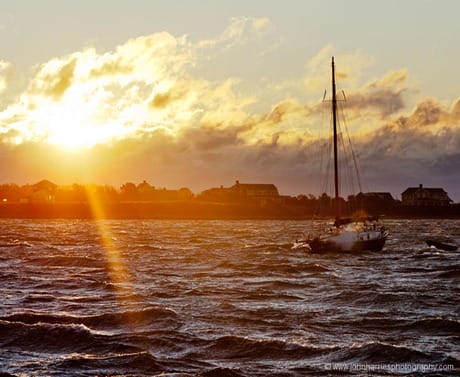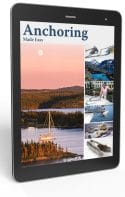
As I write, the still gale force remnants of the Halloween Storm of 2011 are howling in the rigging as Morgan’s Cloud tugs at her anchor and bucks to the chop here in Great Salt Pond at Block Island.
I sometimes call cruising, particularly when tired and crotchety, “death by a thousand decisions”. And deciding where to seek shelter with a storm on the way, particularly when far from home and in unfamiliar waters, can be one of the most stressful calls we voyagers are called upon to make. So here is the thinking process we went through and some of the alternatives we considered before deciding to ride out the blow at Block Island.


Please help me understand the following expression: “All it would have taken for the forecast northeast, backing northwest, wind to turn into a southeast, veering southwest, wind would have been a less than 120 mile change in the storms path.” I want to be able to understand nautical talk and this is a good one (above) for me to practice on.
Please help me use the “120 mile” piece of information to understand how that distance would effect the wind descriptions. A change in wind direction somehow measured by 120 miles results in changing the wind’s description from a “northeast wind-backingnorthwest” to a “southeast wind-veering southwest.”
I really don’t know what that all means and I am sincerely interested in being able to understand and speak the language
Wow Steve, a big one. And anyway, if I tell you what all the lingo means, I won’t look so smart! Just kidding, a really good question. I will have a go at answering:
Backing: Wind changing direction in an anticlockwise direction over time.
Veering: The opposite of backing.
In the northern hemisphere, if a low pressure center passes to the south of you, the wind will back, if to the north, it will veer.
The center of this storm passed about 100 miles southeast of Block Island. So if it had wobbled and passed say 120 miles further west, we would have had veering winds instead of backing.
John, thanks for connecting backing/veering with the passing low. Nobody told me this! Great.
“In the northern hemisphere, if a low pressure center passes to the south of you, the wind will back, if to the north, it will veer.”
Only if the low is moving W to E.
This distinction is important when dealing with hurricane.
Hi Walter,
That’s true, but I wasn’t writing about a hurricane.
John. Great Salt Pond (GSP) is a great anchorage for all the reasons you report plus some. Holding is excellent. I also look at where I am likely to end up if things go pear shaped and GSP would leave you on sand and/or mud most directions. Not sure I would pick it in season though as I consider other boats/skippers a big danger, especially those on moorings. We were one of 4 boats anchored in Onset, Mass. for Hurricane Bob. The mooring field and marina were destroyed. Much damage in the mooring field was from other boats playing bumper cars. We planned them to be downwind when the storm hit and when the wind came around 180 deg there were not enough left to be a problem. The anchored boats planned first and then worked together for a full day to utilize the anchorage fully and lay out ground tackle. The eye went over Newport and we were 20 miles away in the “unnavigable” quadrant and saw 110 knots. All 4 anchored boats were unhurt in any way.
Dick Stevenson, s/v Alchemy, London
Hi Dick,
Now what the heck am I going to do for part two of this post? You just wrote it! Seriously, I agree entirely.
Hi Dick and John
I’d agree, too – having other boats in close proximity is a major worry, and we avoid it if we can. There are places that are so popular in season (for good reasons) they can become death traps if the weather goes bad – the lovely Isles of Scilly are a classic case in my experience.
Having real shoal draft with our Ovni (2’6″) is a big plus, which we use to our advantage whenever possible, allowing us to get closer inshore or into smaller bays where we’re on our own. On the one occasion we were at anchor in winds that reached gale force in the Bay of Cadiz this summer we were the closest boat in to the beach and sat comfortably for 3 days without budging, whilst it was carnage outside us, with boats dragging all over the place. And that wasn’t even in a real blow!
Where we do have to be careful though is not to overdo it, as in the event of a 180 shift we could be up the beach. If we ever find ourselves in a situation where that might happen, we plan to use our kedge on a bahamian moor, which will (hopefully) give us time to sort ourselves out and head for better shelter.
Best wishes
Colin
Hi Colin,
So true. I can’t tell you the number of times I have looked with envy at a lifting keel boat like yours in shallow water way up to windward of the anchored fleet. Out of harms way, and more sheltered as well.
have never been on the hook at gsp but have gazed out over it at night during the summer cruising season from the nicely elevated coast guard station…will never forget the stunning sight of all those mast lights twinkling back at me…must have been at least 100 snugged up vessels that peaceful night…gsp is also where i saw m/v viagra which looked to be of all wood construction and glistening darkly…a most memorable mult-day visit to block island where trophy rock fish abound in summer because that’s where the hand-size squid are summering…this visit was 20 years ago so maybe some of this ambiance has changed since then…hope not…richard in tampa bay…m/v cavu’s skipper
also want to echo all of john’s points in this post as they are so critical to making the difference between just a mildly uncomfortable experience and the gut-wrenching catastrophe we all instinctively want to avoid made even more traumatic because of the speed with which the catastrophe can occur and how irreversible it can easily be…the lesson here is that many of our waterborne situations have important counter-intuitive solutions that behoove us to always consider and normally heed except in the rare cases when we are sure of prevailing conditions for the next 24 hours or so…even then there is a risk…richard in tampa bay…m/v cavu’s skipper
About the only thing better than following John & Phyllis’ advice on how to pick an anchorage in a storm, is to be loaned their “bullet-proof” mooring in Nova Scotia when a hurricane passes nearby. Thank you again for the peace of mind!